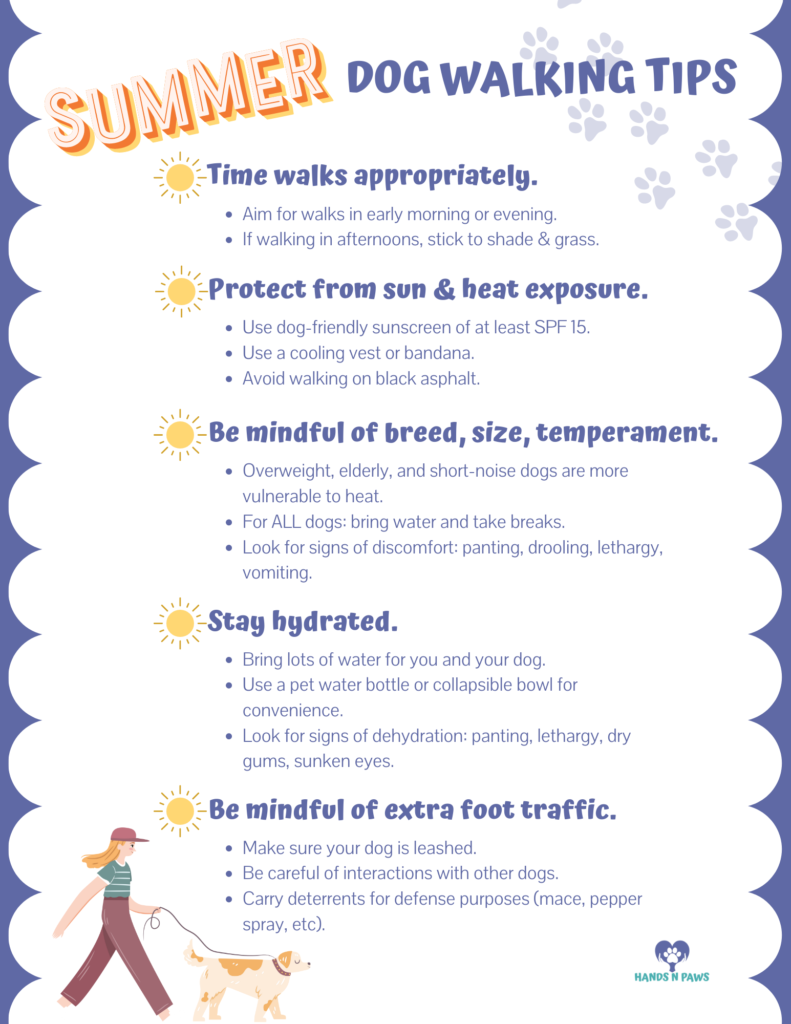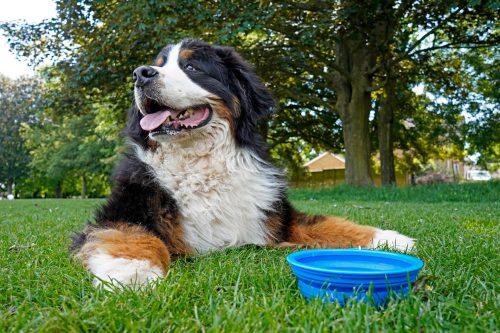Dogs love the summer weather. It allows them to spend more time outdoors, bask in the sunshine, and explore new sights and smells. The warmer weather also provides opportunities for swimming and other water activities, which many dogs enjoy. Additionally, summer is a wonderful time to enjoy lots of dog walking!
Here’s our top 5 safety tips for summer dog walking in Columbus, Ohio.
1. Time Your Walks Appropriately
Timing your walks appropriately is crucial for keeping your dog safe and comfortable during summer weather. If you take your dog out for a walk during the hottest parts of the day (typically between 10 am and 4 pm), they are at risk of overheating, dehydration, and heatstroke. This is especially true for dogs with thick fur or short snouts, such as Bulldogs or Pugs, as they are more susceptible to heat exhaustion.
To prevent this, try to plan your walks for early morning or late evening, when the temperature is cooler. Not only will this keep your dog cooler, but it will also reduce the risk of hot pavement burning their paws. If you must walk during the day, stick to shaded or grassy areas and avoid direct sunlight. Many of our dog walkers in Columbus, Ohio are scheduled for afternoon/midday walks. So, we’re always seeking shady and grassy areas to walk in!
You might also consider checking the pavement before setting out on walks. Especially if it’s black asphalt, heat can easily absorb into paved surfaces and create a hazard for your dog’s paws. Place your hand on the pavement for 10 seconds – if it’s too hot for you, it’s too hot for your dog. Walk on grass or shaded paths instead.
In addition to timing your walks appropriately, it’s important to pay attention to your dog’s behavior during walks. Signs of heat exhaustion in dogs include excessive panting, drooling, lethargy, and vomiting. If you notice any of these symptoms, find a shaded area and offer your dog water immediately. If the symptoms persist, contact a veterinarian for further advice. By taking these necessary precautions, you can help ensure that your dog stays safe and comfortable during summer walks.
2. Protect Your Dog from the Sun
Protecting your dog from the sun is an important aspect of summer safety. Dogs with short or light-colored hair, thin fur, or pink skin are particularly vulnerable to sunburn. When taking your dog for a walk, it’s important to protect them from the sun’s harmful UV rays. Using a dog-friendly sunscreen with an SPF of at least 15 can help prevent sunburn on areas with less hair, such as their nose and ears. Make sure to apply the sunscreen before heading outside and reapply it every few hours or after your dog has been in the water.
NOTE: Our qualified dog walkers in Columbus, Ohio always consult with pet parents first before using any sunscreen on pups they’re walking.
In addition to sunscreen, a cooling vest or bandana can help regulate your dog’s body temperature during walks. These products work by absorbing water and then slowly releasing it, which can help keep your dog cool and comfortable. You can also use a damp towel or cooling pad for your dog to lie on during breaks or after the walk.
It’s important to remember that dogs can overheat quickly, so it’s important to monitor their behavior and take appropriate precautions. Signs of overheating in dogs include excessive panting, drooling, lethargy, and vomiting. If your dog shows any of these signs, stop the walk immediately, move them to a cool and shady area, and give them water to drink. If their symptoms persist, contact a veterinarian as soon as possible.
3. Be Mindful of Breeds, Sizes, and Individual Temperaments
It’s worth noting that comfortability on summer weather walks can also be specific to the breed, size, and groom of your pup.
Some breeds and sizes are more susceptible to heat stroke than others. For example, short-nosed breeds like Bulldogs, Pugs, and Boxers have a harder time regulating their body temperature and are more likely to overheat. Overweight or elderly dogs are also at higher risk for heat stroke.
It’s important to take extra precautions for these dogs when walking in the heat. Keep walks shorter and avoid the hottest parts of the day. A good rule of thumb is to keep walks under 20 minutes for short-nosed breeds or overweight/elderly dogs. It’s also important to bring plenty of water and take frequent breaks in shaded areas.
On the other hand, larger breeds with thicker coats like Siberian Huskies and Alaskan Malamutes may actually enjoy cooler weather more and may be more comfortable during walks in the early morning or late evening. However, it’s still important to monitor them for signs of overheating and to take necessary precautions.
Overall, understanding your dog’s breed and individual needs is key to keeping them safe and comfortable during hot weather walks. Be mindful of signs of discomfort and limitations, and adjust your walk accordingly. Using a combination of breed, size, and temperament can be a very reliable way to determine how comfortable your dog is on summer walks.
4. Stay Hydrated
Staying hydrated is crucial for both you and your fur baby during hot weather walks. Dogs can easily become dehydrated, which can lead to serious health issues such as heat stroke. It’s essential to bring enough water for both you and your dog and offer it frequently, especially during longer walks.
Portable water bowls are a great option for walks, and you can find many that are collapsible and easy to carry. You can also invest in a water bottle with a built-in bowl or a hydration pack designed specifically for dogs. Keep in mind that dogs tend to drink more water after exercising, so make sure to provide enough water to meet their needs.
It’s important to be aware of the signs of dehydration in dogs, including panting, lethargy, dry gums, and sunken eyes. If you notice any of these symptoms, seek shade or air conditioning immediately and offer water. If your dog doesn’t drink water or seems to be getting worse, contact your veterinarian right away.
5. Watch for Signs of Heat Stroke
Heat stroke is a serious condition that can occur when a dog’s body temperature rises to dangerous levels. Signs of heat stroke include excessive panting, vomiting, diarrhea, lethargy, and collapse. If you notice any of these symptoms, move your dog to a shaded or air-conditioned area immediately and provide water. Seek veterinary attention if the symptoms persist or worsen.
You can also act quickly yourself if you notice signs of overheating or heat stroke in your dog. Here’s a step-by-step protocol to follow:
- Move your dog to a cool area: If your dog is showing signs of heat stroke, move them to a cooler area immediately. Get them out of direct sunlight and into a shaded or air-conditioned space.
- Provide water: Offer your dog water to drink. It’s important to make sure they are drinking, but do not force them to drink as it can cause further health issues.
- Cool them down: Use cool water to wet down your dog’s fur, especially around their neck, underbelly, and between their hind legs. You can also use cool, damp towels on their body. Do not use ice water or ice as it can cause the blood vessels to constrict and prevent proper cooling.
- Monitor their condition: Continue to monitor your dog’s condition and behavior closely. Look for any improvement in their symptoms, such as reduced panting or increased energy.
- Seek veterinary attention: If your dog’s symptoms persist or worsen, it’s important to seek veterinary attention immediately. Heat stroke can cause serious health complications such as organ failure, seizures, and even death if left untreated.
Remember, prevention is key when it comes to overheating and heat stroke. By following the tips outlined in this blog article and being mindful of your dog’s individual needs and limitations, you can help ensure a safe and enjoyable summer for both you and your fur kid.
6. Be Mindful of Extra Foot Traffic
During the summer months, there tends to be more foot traffic in parks, on sidewalks, and other popular outdoor areas. This means there are more dogs and people out and about, which can increase the chances of accidents or confrontations. To keep your pup safe during walks, it’s important to take extra precautions.
Firstly, make sure your dog is always on a leash when in public areas. Even the most well-behaved dog can become distracted or agitated and wander off or cause trouble, which could lead to injury or damage. Additionally, be sure to carry a whistle or other deterrent such as mace or pepper spray in case you need to defend yourself or your dog from an aggressive animal.
It’s also a good idea to ensure your dog has proper identification, such as an ID tag on their collar or microchip, in case they do get loose. This will help ensure that they are returned to you safely.

Checklist: Essential Items for Summer Dog Walks in Columbus, Ohio
To ensure the safety and well-being of your dog during summer walks, make sure to bring the following items with you:
- A portable water bottle and bowl. You’ll need plenty of water for both you and your dog.
- Dog-friendly sunscreen to protect your pup’s nose, ears, and other areas with less hair from harmful UV rays.
- A cooling vest or bandana to help regulate your dog’s body temperature.
- Poop bags to clean up after your dog.
- A leash to keep your dog under control and prevent them from running off.
- A whistle or mace for self-defense, in case of any emergencies.
- Your dog’s ID tag, just in case they get loose and need to be returned to you.
You might also consider purchasing a dog walking fanny pack to help you easily carry the items listed above!
Keep Your Pup Safe and Happy on Summer Walks!
By following these top 6 safety tips for summer dog walks in Columbus, Ohio, and being mindful of your dog’s individual needs, you can ensure that your fur baby stays safe, healthy, and happy during summer walks. The key is to make sure your dog is prepared for the warmer weather. Remember to keep them hydrated, watch for signs of heat stroke, and time your walks appropriately. And, don’t forget to bring the essential items listed in the checklist above for a safe and enjoyable summer walk with your dog. Above all, in case of emergencies, be sure to have the number of a local emergency vet on hand.















